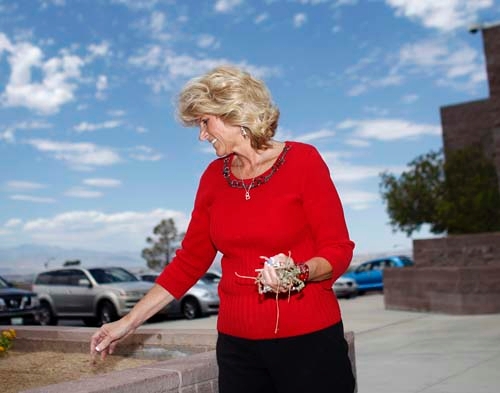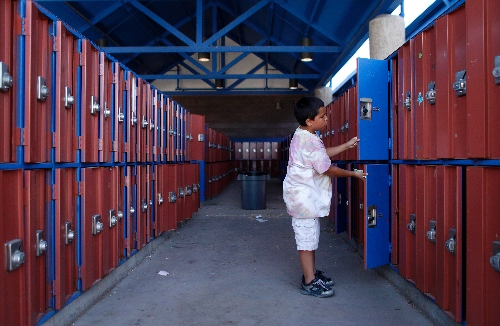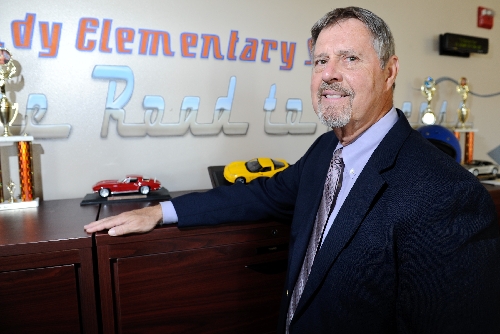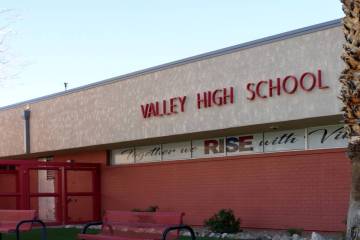Principals cheerfully take bad with good
The polished stone plaque, a pretty trinket carved with 17 inspirational words, is more than just a desk decoration.
"Life isn't about waiting for the storm to pass. It's about learning to dance in the rain."
OK. It reads like the inside of a Dove Chocolate's foil wrapper, minus the candy.
But in the office of O'Callaghan Middle School's new principal, Belinda Jones, it's pertinent.
Jones is taking over one of the lowest-achieving schools in one of the nation's lowest-performing districts, the Clark County School District. Just one of every two O'Callaghan students is proficient in math. Even fewer - 39 percent - can read at grade level, according to state standardized tests administered in the 2010-11 school year.
The school also has failed to meet the standards of the federal No Child Left Behind Act nine out of nine years.
But Jones is walking in willingly. She was in charge of Ullom Elementary School, which met federal standards all six years she was at the helm and just ranked among the district's top performers as a five-star school.
"Going from a five-star school to Needs Improvement Year 8, it took some thought," Jones said in early July, when most principals are off.
But 11 years ago she was a teacher at O'Callaghan, a school on the eastern edge of Las Vegas. She remembers better days when O'Callaghan won a coveted Blue Ribbon for excellence from the U.S. Department of Education.
"I'm ready for a challenge. I want to see these kids succeed."
That same sentiment is shared by three other new principals assigned to Canyon Springs High School and Roundy and Sunrise Acres elementary schools. They're leaving high-performing or improving schools for some of the most challenged campuses in the district. And they're working through the summer because they have a tall order to fill.
FROM BAD TO BETTER
District leaders want big results, fast.
"We expect quick and immediate gains, in a year," said Jeff Geihs, newly named academic manager for Clark County's "turnaround" schools.
The designation gets campuses extra resources because student performance ranks them in the bottom 5 percent of the district's 357 schools.
These four schools also will be closely watched.
"We need to be aggressive in our monitoring, and then corrective action, if the results aren't there," Geihs said. "These schools are, quite frankly, under the microscope."
That also goes for Chaparral, Mojave and Western high schools, which are second-year turnaround schools and posted gains their initial year.
Turnaround principals are also given extra federal dollars and freedom to largely operate the schools as they see fit.
In 2012-13, Roundy and Sunrise Acres will each receive $250,000 in extra funds on top of the $375 per student they already receive in Title 1 funds because their enrollments include high numbers of students living in poverty. O'Callaghan is also a Title 1 school and will receive $500,000 more.
Canyon Springs, not a Title 1 school, will receive $4.1 million over three years.
With autonomy, the sky's the limit in terms of what each school can do with those resources, which is what pushed Principal John Haynel to ignore warnings over leaving Helen Smith Elementary School after four years. It met No Child Left Behind standards seven straight years and was one of eight Nevada schools given Blue Ribbons in the last decade, winning in 2010.
"People would say I'm crazy," Haynel said.
"You just earned five-star status and autonomy," they told him.
His response: "There is no risk. This is our job."
Haynel's now at Roundy, a school near Sahara Avenue and Decatur Boulevard where 85 percent of its students live in poverty and 71 percent have limited English skills.
He's using the extra funding to hire more teachers, increasing the teaching staff from 48 to 55. That will decrease class sizes, the No. 1 contributor to academic performance, he said.
Class sizes will average 16 students in first and second grades. He's shooting for a maximum of 24 students in fifth-grade classrooms.
At other district schools, the average class size is expected to climb to 35 students in fourth and fifth grades next school year.
Class size is also the chief concern at Canyon Springs High School, where Principal Ron Guerzon added 15 teachers, an administrator and several counselors.
"And we're keeping, opposed to cutting," he said of elective programs.
He is adding an art class because students who don't come to school for the core subjects will attend for electives they're passionate about.
SCIENCE OF TEACHING
But class sizes and more programs alone won't generate success, both principals agreed. Like Geihs, Haynel is all about statistically following teachers and students.
Also, Helen Smith teachers won't be given one class and teach everything, as they do in most elementary schools. Instead, different teachers will teach individual subjects, as they do in middle schools and high schools.
"I'm a systems approach kind of principal," Haynel said. "There's a lot of science in education now."
Margarita Gamboa is now in charge of Sunrise Acres Elementary School, near Eastern Avenue and U.S. Highway 95, which she attended as a child.
She's also a supporter of a systematic approach to reform. Previously, the school didn't start the year by giving students benchmarking tests to determine skill levels.
She'll be having teachers testing students every two weeks to measure progress. And teachers, by grade level, will meet with her to discuss progress.
"Otherwise how do I know if students learned?" she said. "We're working smarter, not harder."
She's chosen not to hire more teachers. Her turnaround funding will be spent on training the teachers already there and updating the curriculum and materials.
Her goals are high - she wants a 25 percent increase in students who test as proficient.
"What do they say? 'Shoot for the moon,' " Gamboa said, noting that since the proficiency rate is so low at Sunrise Acres, such gains aren't impossible. Only 32 percent of students read at grade level and 49 percent are proficient in math.
About 83 percent are Hispanic, but that's not an acceptable excuse, said Gamboa, who learned English as a second language.
A HOME AWAY FROM HOME
Jones feels like she's coming home and wants the students to feel the same way. So O'Callaghan is getting a bit of a facelift this summer.
"A lot of cleaning to be done," said Jones, walking through the school courtyard and running down the repair list in her head.
Holes in classroom walls need to be patched. Sterile white walls need color. The color she does have, purple, is wrong. Should be blue.
As she bends over to pick up a discarded shirt wedged beneath a bench, a janitor, one of the few workers present throughout the summer, stops to tell her not to get her hands dirty.
"I'm paid to have dirty hands," he said.
"I wouldn't ask you to do anything I wouldn't do," said Jones, who tossed the shirt in the garbage.
She repeated, "A lot of things to do."
Contact reporter Trevon Milliard at
tmilliard@reviewjournal.com or 702-383-0279.
























